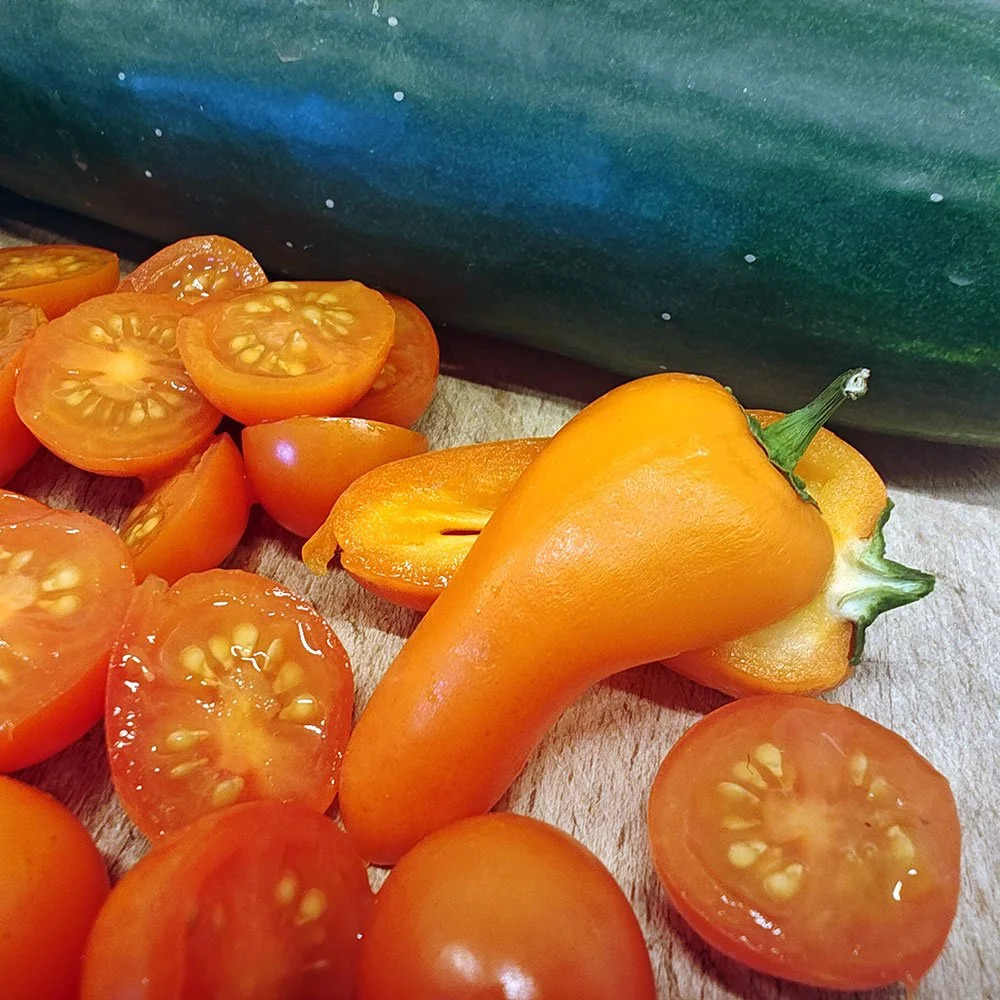What are lectins?
Lectins are naturally occurring proteins found in many plant foods — especially in seeds, legumes, tomatoes, cucumbers, and peppers.
While certain lectins can be challenging for sensitive individuals, they’re not inherently “bad.” In fact, many nutrient-rich, whole foods contain lectins — and most people tolerate them just fine, especially when properly prepared.
Tomatoes, peppers, and cucumbers are high in lectins that can be problematic for some people.
Why Do Plants Contain Lectins?
Lectins are part of a plant’s natural defense system — helping protect seeds from pests, mold, and animals.
That means you’ll find lectins most concentrated in:
Seeds and seed coats (think beans, grains, squash seeds)
Peels and skins (especially of cucumbers, eggplant, tomatoes)
Unripe or raw plant parts
What Do Lectins Do in the Human Body?
In the human body, certain lectins may cause issues for some — especially if digestion is already compromised.
Here’s what they can do in sensitive individuals:
Bind to cells in the gut lining and interfere with nutrient absorption
Trigger digestive symptoms like gas, bloating, or fatigue in sensitive individuals
Stimulate the immune system, which can be problematic if your gut barrier is already stressed
But this is important — not everyone is sensitive to lectins! Most people digest them just fine when properly prepared (see below).
Common Foods That Contain Lectins
Not all lectin-containing foods are problematic — but awareness helps you choose what’s best for your body.
1. Beans (kidney, black, pinto)
Beans are naturally rich in lectins — and also packed with fiber, protein, and minerals. For some people, undercooked or improperly prepared beans can cause bloating, gas, or even joint stiffness.
What helps: Soaking the beans overnight and pressure cooking them can dramatically reduce lectin content and make them easier to digest.
2. Nightshades (tomatoes, eggplant, bell peppers)
These vibrant vegetables are beloved in many cuisines, but for certain folks, they may trigger joint pain, skin flares, or low-grade inflammation.
What helps: Try peeling and cooking these vegetables (especially tomatoes and eggplant) to reduce their lectin load and increase digestibility.
3. Cucurbits (cucumbers, squash, and pumpkin seeds)
Cucurbit family plants can sometimes lead to bloating or fatigue — especially when eaten raw or in large quantities.
What helps: Peeling and removing the seeds is a simple way to minimize lectins while still enjoying the cooling, hydrating qualities of these foods.
4. Grains (Wheat and barley)
In addition to lectins, these grains contain gluten and other compounds that can be irritating for people with digestive or cognitive sensitivities (think brain fog, bloating, sluggish energy).
What helps: Traditional fermentation methods, like sourdough, help break down lectins and gluten proteins. For some people, though, it’s best to reduce or avoid modern wheat altogether — especially if gluten sensitivity or autoimmune conditions are present.
how to Reduce Lectins
You don’t need to avoid all lectins. Traditional preparation methods can make a big difference in how your body responds.
Try these traditional prep techniques:
Soaking + sprouting: especially helpful for beans, lentils, seeds, and grains
Pressure cooking: dramatically lowers lectin content in beans and legumes
Peeling + deseeding: reduces lectins in cucumbers, squash, tomatoes
Fermenting: like sourdough bread or pickled cucumbers — this breaks down both lectins and some anti-nutrients
Cooking thoroughly: especially important with winter squash, eggplant, beans
What I Recommend
As a Nutritional Therapy Practitioner, my approach is personalized — not dogmatic. Lectins are not the enemy, and they can offer clues about how your body is processing certain foods.
If you're struggling with:
Persistent digestive issues
Unexplained fatigue
Joint discomfort or puffiness
Autoimmune flares or food reactions
...then investigating lectin sensitivity may be worth exploring.
Most people feel best when digestion is supported, inflammation is reduced, and food feels energizing — not depleting. If something feels "off," we can explore whether food sensitivities (including lectins) are part of the picture.
Are Lectins in Processed Foods?
Yes! And often in ways that are harder to detect.
Processed foods made from lectin-rich ingredients (like wheat, soy, corn, or legumes) still contain lectins — and in some cases, those lectins are not neutralized through traditional preparation methods like soaking or fermenting.
Why Are Processed Lectins More Problematic?
When food is factory-processed, it usually skips the time-consuming prep methods (like soaking beans or fermenting dough) that help reduce lectins in home-cooked or traditional diets. That means:
Wheat lectins often remain active in processed foods made with quick-rise doughs
Soy lectins in soy protein isolate or soy flour aren’t typically deactivated
Corn lectins in chips or tortillas made from non-nixtamalized corn can be harder on the gut
Legume flours (like chickpea or lentil flour) used in snacks or gluten-free products may still carry active lectins
Examples of Processed Foods That May Contain Lectins:
Breakfast cereals made with wheat, barley, corn, or soy
Granola or protein bars with soy protein or peanut flour
Packaged breads and crackers
Canned or packaged beans
Gluten-free snacks made from lentil, chickpea, or bean flours
Nutritional Therapy Tip:
If you’re exploring how lectins might be affecting your digestion or energy, start with removing factory-processed foods first. They tend to carry more inflammatory triggers overall — not just lectins. Many people tolerate whole, traditionally prepared foods much better.
Want to Dive Deeper into Lectins?
A book that has popularized this topic (and sparked a lot of curiosity) is The Plant Paradox (affiliate link) by Dr. Steven Gundry. While I don’t agree with everything in it, I appreciate how it raises awareness around food sensitivities — and how we’re all bio-individual.
Final Thoughts
Lectins are found in many nourishing foods — and for most people, they’re not a problem when prepared properly. No need to fear them — just get curious. With the right cooking methods and a personalized approach, these foods can be part of a healthy, vibrant diet.
Preparation matters (soak, sprout, cook, ferment!)
Bioindividuality is key — not all bodies respond the same
